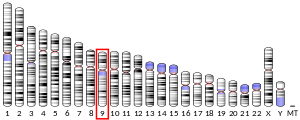ROR2
ROR2신경영양성 티로신 키나제, 수용체 관련 2로도 알려진 티로신-단백질 키나제 트랜스막브레인 수용체 ROR2는 [5][6][7]염색체 9의 긴 팔의 위치 9에 위치한 ROR2 유전자에 의해 인간에서 암호화되는 단백질이다.이 단백질은 뼈와 연골의 성장에 영향을 미친다.ROR2는 수용체 티로신 키나아제 유사 고아 수용체(ROR) 계열의 구성원이다.
기능.
이 유전자에 의해 코드된 단백질은 세포 표면 수용체의 ROR 서브패밀리에 속하는 수용체 티로신 키나아제 및 타입 I 트랜스멤브레인 단백질이다.단백질은 연골세포의 조기 형성에 관여할 수 있으며 연골과 성장판 [5]발달에 필요할 수 있다.
임상적 의의
이 유전자의 돌연변이는 말단 지골과 손톱의 저형성/형성증으로 특징지어지는 골격 질환인 B형 상완화증을 일으킬 수 있다.또한, 이 유전자의 돌연변이는 일반화된 사지뼈의 단축을 수반하는 골격 이형성, 척추의 분할 결함, 상염색체 [5]열성형 호비노 증후군을 일으킬 수 있다.
레퍼런스
- ^ a b c GRCh38: 앙상블 릴리즈 89: ENSG00000169071 - 앙상블, 2017년 5월
- ^ a b c GRCm38: 앙상블 릴리즈 89: ENSMUSG000021464 - 앙상블, 2017년 5월
- ^ "Human PubMed Reference:". National Center for Biotechnology Information, U.S. National Library of Medicine.
- ^ "Mouse PubMed Reference:". National Center for Biotechnology Information, U.S. National Library of Medicine.
- ^ a b c "Entrez Gene: receptor tyrosine kinase-like orphan receptor 2".
- ^ Masiakowski P, Carroll RD (December 1992). "A novel family of cell surface receptors with tyrosine kinase-like domain". J. Biol. Chem. 267 (36): 26181–90. doi:10.1016/S0021-9258(18)35733-8. PMID 1334494.
- ^ Oldridge M, Fortuna AM, Maringa M, Propping P, Mansour S, Pollitt C, DeChiara TM, Kimble RB, Valenzuela DM, Yancopoulos GD, Wilkie AO (March 2000). "Dominant mutations in ROR2, encoding an orphan receptor tyrosine kinase, cause brachydactyly type B". Nat. Genet. 24 (3): 275–8. doi:10.1038/73495. PMID 10700182. S2CID 40179047.
추가 정보
- Oguri M, Kato K, Yokoi K, et al. (2010). "Assessment of a polymorphism of SDK1 with hypertension in Japanese Individuals". Am. J. Hypertens. 23 (1): 70–7. doi:10.1038/ajh.2009.190. PMID 19851296.
- Schwarzer W, Witte F, Rajab A, et al. (2009). "A gradient of ROR2 protein stability and membrane localization confers brachydactyly type B or Robinow syndrome phenotypes". Hum. Mol. Genet. 18 (21): 4013–21. doi:10.1093/hmg/ddp345. PMID 19640924.
- Wright TM, Rathmell WK (2010). "Identification of Ror2 as a hypoxia-inducible factor target in von Hippel-Lindau-associated renal cell carcinoma". J. Biol. Chem. 285 (17): 12916–24. doi:10.1074/jbc.M109.073924. PMC 2857057. PMID 20185829.
- Forsman M, Pääkkönen V, Tjäderhane L, et al. (2008). "The expression of myoglobin and ROR2 protein in Dupuytren's disease". J. Surg. Res. 146 (2): 271–5. doi:10.1016/j.jss.2007.06.022. PMID 17996904.
- Sammar M, Sieber C, Knaus P (2009). "Biochemical and functional characterization of the Ror2/BRIb receptor complex". Biochem. Biophys. Res. Commun. 381 (1): 1–6. doi:10.1016/j.bbrc.2008.12.162. PMID 19135982.
- Yerges LM, Klei L, Cauley JA, et al. (2009). "High-density association study of 383 candidate genes for volumetric BMD at the femoral neck and lumbar spine among older men". J. Bone Miner. Res. 24 (12): 2039–49. doi:10.1359/jbmr.090524. PMC 2791518. PMID 19453261.
- O'Connell MP, Fiori JL, Xu M, et al. (2010). "The orphan tyrosine kinase receptor, ROR2, mediates Wnt5A signaling in metastatic melanoma". Oncogene. 29 (1): 34–44. doi:10.1038/onc.2009.305. PMC 2803338. PMID 19802008.
- Morioka K, Tanikawa C, Ochi K, et al. (2009). "Orphan receptor tyrosine kinase ROR2 as a potential therapeutic target for osteosarcoma". Cancer Sci. 100 (7): 1227–33. doi:10.1111/j.1349-7006.2009.01165.x. PMID 19486338. S2CID 205234926.
- Enomoto M, Hayakawa S, Itsukushima S, et al. (2009). "Autonomous regulation of osteosarcoma cell invasiveness by Wnt5a/Ror2 signaling". Oncogene. 28 (36): 3197–208. doi:10.1038/onc.2009.175. PMID 19561643.
- Patton MA, Afzal AR (2002). "Robinow syndrome". J. Med. Genet. 39 (5): 305–10. doi:10.1136/jmg.39.5.305. PMC 1735132. PMID 12011143.
- Liu Y, Rubin B, Bodine PV, Billiard J (2008). "Wnt5a induces homodimerization and activation of Ror2 receptor tyrosine kinase". J. Cell. Biochem. 105 (2): 497–502. doi:10.1002/jcb.21848. PMID 18615587. S2CID 10333821.
- Akbarzadeh S, Wheldon LM, Sweet SM, et al. (2008). "The deleted in brachydactyly B domain of ROR2 is required for receptor activation by recruitment of Src". PLOS ONE. 3 (3): e1873. Bibcode:2008PLoSO...3.1873A. doi:10.1371/journal.pone.0001873. PMC 2268744. PMID 18365018.

- Brunetti-Pierri N, Del Gaudio D, Peters H, et al. (2008). "Robinow syndrome: phenotypic variability in a family with a novel intragenic ROR2 mutation". Am. J. Med. Genet. A. 146A (21): 2804–9. doi:10.1002/ajmg.a.32530. PMID 18831060. S2CID 30597404.
- Pacheco II, Macleod RJ (2008). "CaSR stimulates secretion of Wnt5a from colonic myofibroblasts to stimulate CDX2 and sucrase-isomaltase using Ror2 on intestinal epithelia". Am. J. Physiol. Gastrointest. Liver Physiol. 295 (4): G748-59. doi:10.1152/ajpgi.00560.2007. PMID 18703641.
- Yoshida T, Kato K, Yokoi K, et al. (2009). "Association of gene polymorphisms with chronic kidney disease in Japanese individuals". Int. J. Mol. Med. 24 (4): 539–47. doi:10.3892/ijmm_00000263. PMID 19724895.
- Kjaer KW, Tiner M, Cingoz S, et al. (2009). "A novel subtype of distal symphalangism affecting only the 4th finger". Am. J. Med. Genet. A. 149A (7): 1571–3. doi:10.1002/ajmg.a.32905. PMID 19533773. S2CID 31791104.
- Wright TM, Brannon AR, Gordan JD, et al. (2009). "Ror2, a developmentally regulated kinase, promotes tumor growth potential in renal cell carcinoma". Oncogene. 28 (27): 2513–23. doi:10.1038/onc.2009.116. PMC 2771692. PMID 19448672.
- Li C, Chen H, Hu L, et al. (2008). "Ror2 modulates the canonical Wnt signaling in lung epithelial cells through cooperation with Fzd2". BMC Mol. Biol. 9: 11. doi:10.1186/1471-2199-9-11. PMC 2254434. PMID 18215320.

- Lv D, Luo Y, Yang W, et al. (2009). "A novel single-base deletion in ROR2 causes atypical brachydactyly type B1 with cutaneous syndactyly in a large Chinese family". J. Hum. Genet. 54 (7): 422–5. doi:10.1038/jhg.2009.48. PMID 19461659.
- Yoshida T, Kato K, Yokoi K, et al. (2010). "Association of genetic variants with hemorrhagic stroke in Japanese individuals". Int. J. Mol. Med. 25 (4): 649–56. doi:10.3892/ijmm_00000388. PMID 20198315.






